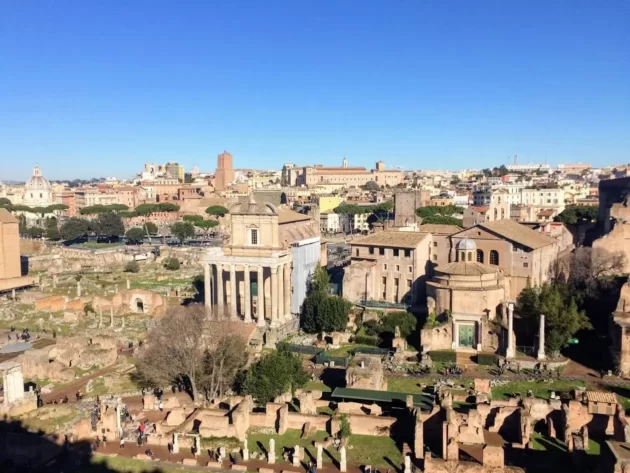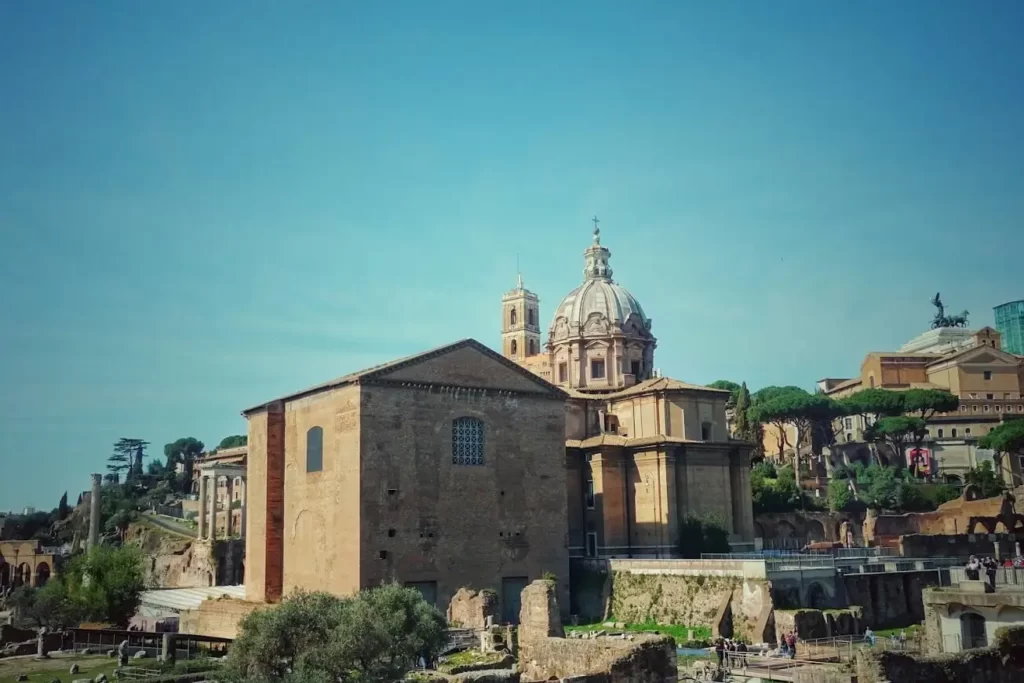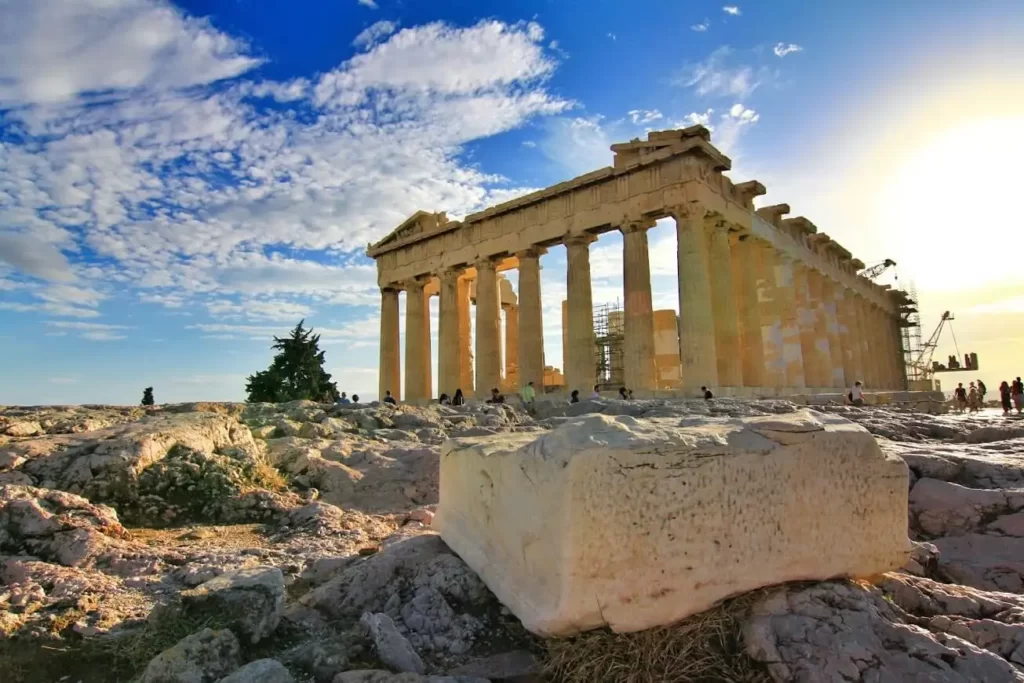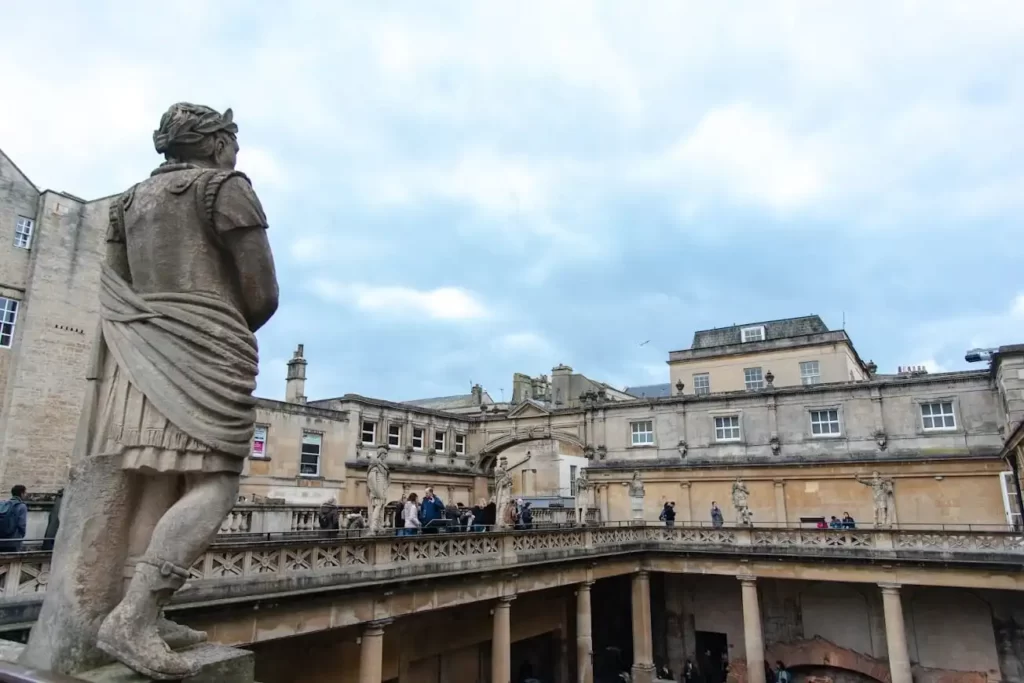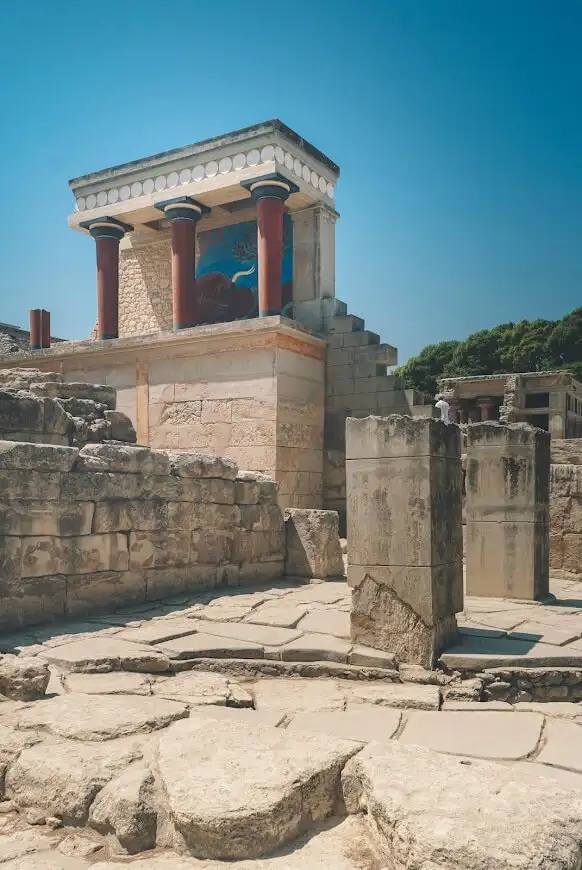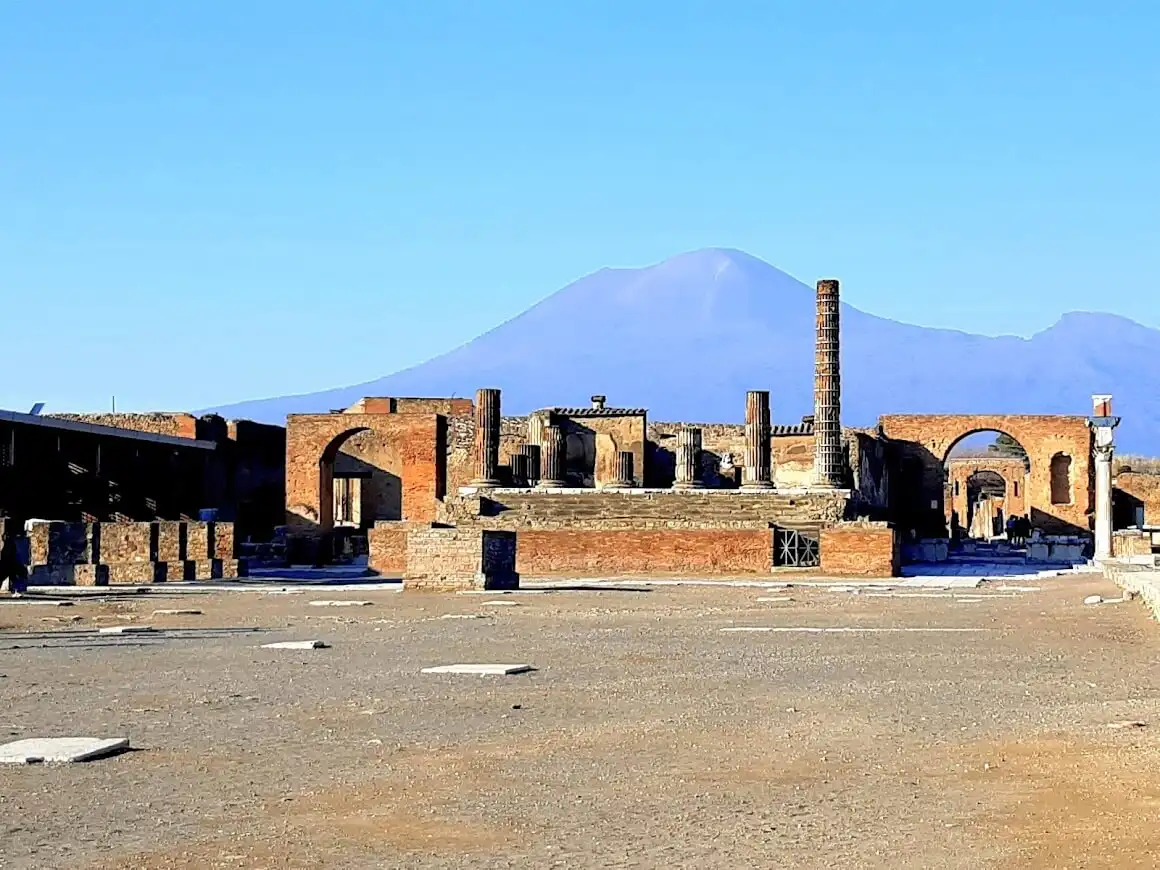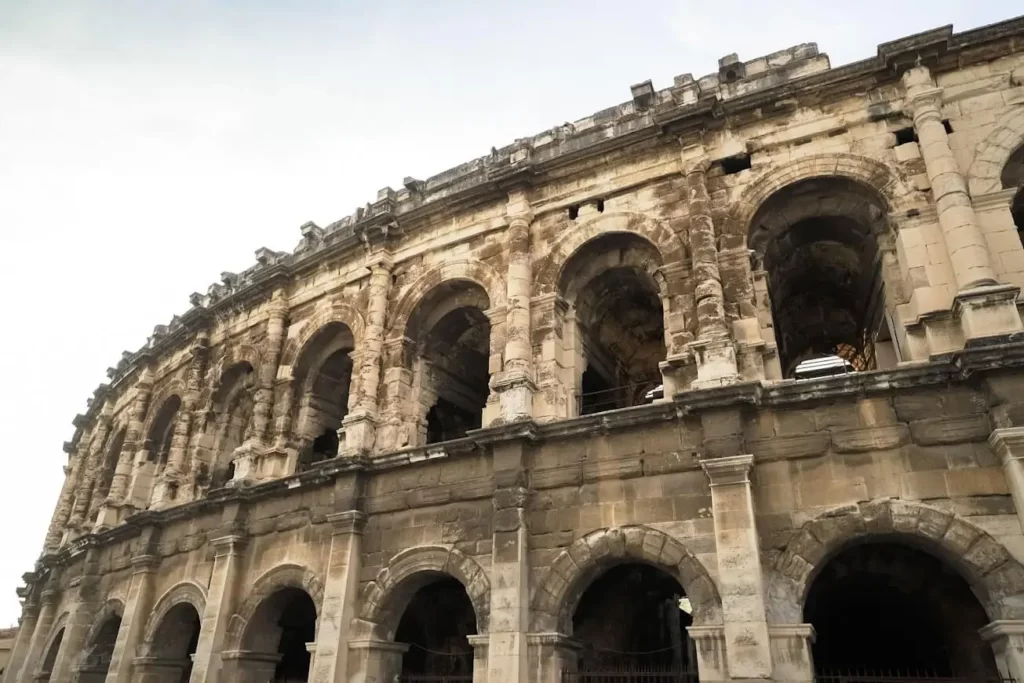Besides visiting museums, one of the best ways to learn about local history and culture while travelling is by exploring the archaeological sites. Since there are so many of them around Europe, I asked some of my fellow travel bloggers to share with me their favourite places. And we’ve created this list of 20 archaeological sites you have to visit in Europe for you.
Archaeological sites you have to visit in Europe
#1 – Capitolium & Roman Forum in Brescia, Italy
The Capitolium Temple, together with the Republican Sanctuary and the Roman Theatre that form the rest of the archaeological complex in Brescia, are some of the best-preserved ruins in northern Italy.
The main temple, the remains of which can still be explored today, was built in 73 AD by the Roman emperor and founder of the Flavian dynasty, Vespasian. Standing prominently in ancient Brescia (then Brexia), the temple was damaged in 462 AD when Attila the Hun destroyed Brescia along with Verona, Bergamo, and Vicenza, and was then buried by a landslide. The temple wasn’t rediscovered until an 1826 excavation. Today, a portion of the main façade, courtyard and columns still stand.
Underneath the temple, you’ll find the oldest structure in the complex, a very well preserved Republican sanctuary. It was built in 1st century BC and was buried in 73 AD when the Capitolium Temple was built on top of it. The fact that it was buried for so long kept it very well preserved over the centuries. The sanctuary has been excavated and restored, but still has the original mosaic floor and the frescoes on the walls, which is incredible given how long ago it was built!
The last structure you can visit is the Roman Theatre, found east of the Capitolium building. As one of the largest theatres in northern Italy, the theatre could house up to 15,000 spectators in its prime. It was severely damaged in an earthquake but has since been restored and is lovely to explore and visit.
The Capitolium can be found on Via dei Musei, very close to the Brescia’s city centre and the Castello di Brescia. Tickets to visit all three sites are 8 euros and can be purchased online or from the ticket office on site.
Ioana from The World Is My Playground
#2 – Palatine Hill in Rome, Italy
Palatine Hill is one of the most ancient sites in Rome and was one of the most desirable places to live in Roman times. Standing forty metres above the Roman Forum on one side and the Circus Maximus on the other, it is the most famous of Rome’s seven hills.
Emperor Augustus was born and lived there, in House of Augustus, one of the best-preserved buildings on the hill, together with his wife’s House of Livia. Other Roman Emperors lived on the Hill too, in Domus Augustana, a vast palace that was built in two levels.
Palatine Hill is a great place to escape the hustle and bustle of the city, where you can relax while you stroll and discover this historic site. If you have at least two days in Rome, Palatine Hill is a must-visit. Highlights you must not miss are the Domus Flavia, an area used for public functions, the Temple of Cybele, the centre of a fertility cult, and the impressive Stadium, which was part of the imperial palace.
The Hill can be accessed from the Roman Forum, from Via dei Fiori Imperiale, or from Via di San Gregorio. Admission to the Palatine Hill is included in a combined ticket that also includes the Colosseum and the Roman Forum.
Teresa from Brogan Abroad
#3 – Acropolis in Athens, Greece
A visit to the Acropolis should be on every culture lover’s travel bucket list. Possibly the most important site in ancient Greece, it looms large in the imaginations of people living the world over.
Rising high above Athens, you can see the Parthenon atop the Acropolis from all over the city. Other interesting sites on the Acropolis include the Propylaia, the Erechthion, and the Odeon of Herodes Atticus.
Ancient Greeks have been using the site since 5000 BC, though the most famous buildings here were erected during the age of Pericles, which has been given the nickname the “Golden Age of Athens,” during the 5th century BC. Astonishingly, the Parthenon was built in just ten years.
When you visit, make sure to buy a skip-the-line ticket if you plan on visiting during the high season, especially from June through August (though it can be crowded even in April and October).
You’ll also want to make sure you spend time visiting the Acropolis Museum, which is the dedicated museum that houses the artefacts that have been recovered from the Acropolis. Preserving them here keeps them from being damaged by weather, and you’ll also learn great historical context to the items as you walk around the building.
Stephanie from Sofia Adventures
#4 – Roman Baths in Bath, England
Although Bath looks like a classic English town on first glance, it houses one of Europe’s most beautiful ancient ruins. Located about an hour and a half west of London by train, the city’s famous Roman Baths are an incredible archaeological site worth visiting.
The Roman Baths, known as Aquae Sulis in ancient times, date back to 70 AD and represent the blending of the religion and customs of the Romans with the Celts. The Baths served primarily as a social gathering spot for the Romans, and over time became known for its healing powers.
The Roman Baths would become one of the most sought-after baths outside of Italy. Even the future Queen Anne made a trip to Bath during the late seventeenth century in the hope of curing various ailments, namely gout. Today you can head next door to the Pump Room for a glass of this water, which contains 43 minerals.
Thought to be one of the best-preserved Roman ruins in the world, the Baths have been excavated to show us a picture of what daily life would have been like in those early days. A museum has been built around the ruins to give visitors an even clearer picture of what Roman life would look like. The Roman Baths are open daily to visitors, except on December 25th and 26th, and are open as late as 9:00 p.m. in the summer. Visiting in the evening could be a nice romantic experience.
Theresa from Fueled By Wanderlust
#5 – Baths of Caracalla in Rome, Italy
Some of Rome’s most fascinating ruins, the Baths of Caracalla are also a working archaeological site. They were built in the 3rd century AD and were used for over 300 years by the people of Rome as their primary public bathing facility. In their prime, the baths could accommodate 1,600 bathers who enjoyed three main bathing chambers, open-air swimming pools and gardens as well as a huge public library. It was a huge site built with millions of bricks and comprising of at least 252 columns.
An earthquake in 847 destroyed the baths, but they are the most significant Roman bathhouse ruins to survive the centuries. Today you can visit the site and admire the elaborate mosaics, sculptures and frescoes that once adorned the bathhouse. For the best experience, be sure to pick up a virtual reality guide from the information centre. This impressive virtual reconstruction of the site will help you visualise the remarkable scale of the baths in all their glory. It’s also interesting to watch the archaeologists at work uncovering new treasures at the ancient baths.
The Baths of Caracalla are just a short walk from Circus Maximus, with the closest metro stop being Circo Massimo.
Katy from Untold Morsels
⤷ Read more about some things to do in Rome in my blog post here
#6 – Zaragoza, Spain
Zaragoza is a city located in north-eastern Spain, with a history dating back thousands of years, to the “Caesaraugusta” period – over 2,050 years ago. It’s easy to visit from Barcelona or Madrid to Zaragoza by train, and visit it on a day trip.
Although the city is famous for its street art, square in the old town with its famous fountain and Basilica, it also has one of the most impressive archaeological sites in Europe. Its rich Roman history is definitely one of the biggest surprises in the city.
Zaragoza is home to two archaeological sites that could be visited. The first one is Roman theatre ruins at Museo del Teatro Romano de Caesaraugusta. And the other one is the forum museum, Museo del Foro de Caesaraugusta, where visitors can see the excavated remains of the city right under the main square of modern-day Zaragoza. It looks like there is an entire city just beneath today’s city structure.
Mikkel from Sometimes Home
#7 – Vindolanda, England
Vindolanda was a Roman fort town south of the eastern section of Hadrian’s Wall in northern England. It was occupied for about 300 years and was the residence of Roman soldiers, their families, and supporting services.
Two excellent museums of Roman artefacts are located near the site. The Roman Army Museum features several exciting finds, including the only surviving Roman Army helmet crest. The museum also plays a 20-minute film dramatizing what life was like for soldiers on the northern frontier of the Roman Empire.
At the Vindolanda ruins, you can see archaeologists digging at the extensive site. The site is quite broad and deep. It’s estimated that, at the current rate of excavation, the site won’t be uncovered entirely for more than 100 years. Because many of the artefacts were buried more than six meters deep, they were found in a remarkable state of preservation due to the lack of oxygen.
The museum at Vindolanda conserves and displays such finds as Roman shoes, armour, jewellery and coins. Perhaps the most interesting are wooden writing tablets. Among the tablets is the earliest known example of a woman’s handwriting – a birthday party invitation from one Roman noblewoman to another.
Tom from Travel Past 50
#8 – Stonehenge, England
Stonehenge is one of the best-known archaeological sites in Europe and is visited easily as a day trip from London.
Stonehenge is a UNESCO World Heritage Site and is one of the most famous attractions in the United Kingdom. The Stone Circle is believed to have been constructed during the Bronze Age. There are still many questions regarding the construction and the purpose of the stones.
At the Stonehenge Site, there is a visitor’s centre with a museum dedicated to the history of the stone circle, archaeological objects discovered on the site, and what life was like during the era in which Stonehenge was constructed. There are also Neolithic houses nearby the visitor’s centre, where you can learn about what life was like over 4,500 years ago. From the visitor’s centre, there is a shuttle that will take you to the Stone Circle.
Stonehenge can be visited either through a guided tour or via public transportation. If you’re visiting Stonehenge from London, you can take the train from London Waterloo Station to Salisbury. From Salisbury, there is a Stonehenge Tour Bus (£16 for adults) that will take you directly to the site. This bus is a hop-on-hop-off style bus that will also take you to various locations around Salisbury.
Sydney from A World In Reach
#9 – Glanum, France
Just outside the beautiful town of Saint-Rémy-de-Provence in Southern France lies the remains of another ancient city, Glanum. This Roman town dates back to the 2nd century BC, but it lay hidden mainly after being abandoned in 260 AD until excavations began at the beginning of the 20th century.
What archaeologists discovered after thousands of years of neglect are today some of the most revered historical sites in Provence. The city wears evidence of many changes of rule, and these styles of architecture overlap to create the spectacle you’ll visit today. You will find the remains of both Hellenistic and Roman settlements clearly visible, and the effect is mesmerising. Walk down the ‘main street’ with its covered drains still trickling with water, visit the thermal baths, gaze up at the twin temples and peer into the various caves and wells. The entire site doesn’t take long to discover – around two hours will suffice – but it’s a joy to witness such grand artistry and delve into this ancient civilisation for a brief moment in time. Visit in spring, and you’ll be rewarded with an even more colourful scene as the entire town is punctuated with blossoming trees.
There’s a modest fee to enter (€8 for adults), but it’s free for children, which means visiting Glanum as a family won’t break the bank. Just be warned that you will need to pay for parking unless you walk a small distance from Saint-Rémy-de-Provence. The reception staff will equip you with a map in your language so you can make your way around the site at your own leisure, or you can purchase an audio guide for 3 euros. On-site facilities include a small museum, gift shop and café.
Nadine from Le Long Weekend
⤷ Read more about places related to Vincent van Gogh in Saint-Rémy-de-Provence
#10 – The Neapolis Archaeological Park of Syracuse, Italy
The Neapolis Archaeological Park of Syracuse is one of the most important sites of Ancient Greek history in Italy. Located in the south-east of Sicily, the large park contains a well preserved Greek amphitheatre (5th – 3rd century BC) which is still used today for theatrical events. There are many ancient quarries in the park, including the Ear of Dionysius, a cave-like space where visitors can recreate the echoes of prisoners once held captive there by the Emperor Dionysius.
There is a less well preserved 2nd century Roman amphitheatre which was partly destroyed by the Spanish who used the stone to build the city of Ortigia. Also of interest is the huge sacrificial altar of Hieron II dating back to the 3rd century BC.
The park is, without doubt, one of the highlights of visiting Syracuse. It is two kilometres north-west of Ortigia (the historical heart of the city) and can be reached from there by public transport or car, and parking is available close by. The archaeological park is open daily while the nearby Museo Paolo Orsi (10 minutes walk) which contains many artefacts from the park, is closed on Mondays.
Annabel from Smudged Postcard
#11 – Brú na Bóinne, Ireland
Brú na Bóinne is a group of ancient passage tombs and monuments in eastern Ireland that showcase the architectural ingenuity, artistic endeavours, and sacred ceremonies of the people that settled near the River Boyne during the prehistoric period.
The archaeological complex consists of an impressive collection of megalithic art, numerous ceremonial sites, and some sizeable grassy mounds concealing tombs older than the Egyptian pyramids. The three largest passage graves are Newgrange, Knowth and Dowth, but only Newgrange and Knowth can be visited with a guided tour.
During a tour of the passage graves, you can see engraved kerbstones and peer down long passageways leading into the tombs. At Newgrange, visitors even get to go inside the tomb’s chamber and discover its astronomical alignment. The site also has a visitor centre with informative exhibits, including a full-scale replica of the interior of Newgrange and a Neolithic house.
Brú na Bóinne is located about 40 km north of Dublin, in County Meath, so can easily be visited as a day trip from the city. The closest communities are the village of Donore and town of Drogheda.
Rhonda from Travel? Yes Please!
⤷ Read more about Brú na Bóinne on a link here
#12 – Minoan Palace of Knossos, Greece
One of the oldest cities in Europe, Knossos, is located on the Greek island of Crete, 5 kilometres from Heraklion. It was the centre of Minoan civilisation, and the first settlers lived there as early as the Neolithic period. At its peak, it hosted around 100,000 people. Knossos was abandoned at around 1,380–1,100 BC.
One of the most famous legends about the place is related to Minotaur. He was depicted as a half-bull, half-man monster living in a maze. A young prince from Greece came to Crete and had to fight Minotaur. The daughter of the local king Minos fell in love with the prince and gave him a ball of yarn before he went into the labyrinth. So the prince could find his way out of the maze after he had killed Minotaur. The labyrinth of stone walls and the painting of a bull in Knossos strongly resemble this legend.
Currently, the Palace of Knossos is available for visitors. The first excavation of the site was started in 1878, and the restoration has continued since then. Tourists can enjoy the impressive multi-story building fragments which reveal the imposing palace of the past. There are enormous columns, staircases, and a maze of walls. It’s possible to go on a self-guided tour or join a group with a guide at the info centre. There are several other archaeological places nearby that can be included in a road trip day in Crete.
Una from Wandernity
#13 – Herculaneum, Italy
Not far from Naples, in the shadow of Vesuvius, you’ll find one of Europe’s best archaeological sites. The Roman town of Herculaneum was destroyed by the same volcanic eruption that buried Pompeii, but in a different way. While Pompeii was buried in rocks that destroyed the roofs of its buildings and almost everything above the ground floor, in Herculaneum the town was hit by a 100 mph storm of superheated ash and poisonous gas.
What that means for visitors to Herculaneum is that the site is far better preserved than Pompeii. Many houses still have their upper floors, and even wooden balconies and shop fittings have survived. Even better, although the excavations at Herculaneum are far smaller than the site at Pompeii (much of the ancient town is buried under modern Ercolano), Herculaneum receives only ten per cent of Pompeii’s visitor numbers, meaning that it’s possible to visit and have its atmospheric streets almost to yourself.
There’s a small museum at Herculaneum, and you can hire audio guides. However, it’s good to read as much as you can about the site before your visit. Visiting Herculaneum is also easily combined with climbing Mount Vesuvius. Seeing the still-smoking crater, then visiting Herculaneum is a perfect day exploring one of the most impactful archaeological sites in Europe.
Helen from Helen On Her Holidays
#14 – Pompeii, Italy
Of the archaeological sites in Italy, Pompeii may be the most morbidly fascinating. Located 242 km south of Rome, Pompeii was once a thriving ancient metropolis with about 20,000 residents. Today, it’s a well-preserved ghost town that gives tourists and archaeologists alike a glimpse into the lives of those who lived there thousands of years ago.
Pompeii is situated at the foot of Mount Vesuvius, which is still an active volcano. When it erupted in 79 AD, Pompeii was buried under nearly 12 meters of ash and lava. While bad news for the residents then, the effect was that Pompeii was frozen in time until it was rediscovered in 1748.
Today visitors can wander down its eerie cobbled streets and explore former homes and businesses. There are two main theatres that you can visit, as well as the oldest surviving Roman amphitheatre in the world. Tourists can even marvel at several of Pompeii’s famous human plaster casts.
The easiest way to get to Pompeii is via train from Rome’s Termini Station. Take the high-speed train to Naples, and from Naples take the Circumvesuviana train to the Pompeii Scavi station.
Maggie McKneely from Pink Caddy Travelogue
⤷ Read more about Pompeii on a link here
#15 – Cenobio de Valerón on Gran Canaria, Spain
Cenobio de Valerón on the Spanish island of Gran Canaria is one of the most fascinating archaeological sites in Europe. The island is located on the north-western coast of Africa. The fact that the island has so much to offer in terms of history, nature and weather, makes it all the more an attractive destination for discovering ancient sites.
The Cenobio de Valerón, also known as the Caves of Valeron or Monastery of Valeron, is an ancient complex system of caves. The caves are located on the northern part of the island in the Municipality of Santa Maria de Guia, directly on the cliff.
In short, it is the largest pre-Hispanic collective granary (with 298 compartments and 350 storage places). It was actually built before the Roman era. However, the natives of the islands used the caves until the late 15th century, right up until the island got conquered. The incredible size of these caves just demonstrates the historical importance of the islands’ agriculture.
Michelle Minnaar from Greedy Gourmet
#16 – Roman Forum in Zadar, Croatia
Built between the 1st century BC and the 3rd century AD under the directive of the first Roman emperor Augustus, the Roman Forum in Zadar is the largest one in Croatia. Zadar was a Roman settlement from the 1st century BC until the 5th century AD when the Roman Empire fell. Viewing the remnants of the once-magnificent forum is one of the most exciting things to do in Zadar, especially if you love architecture, history and culture.
Only discovered in the 20th century, the ruins show the layout of an impressive space that was the centre of public life during Roman times, much as it was in Rome. One intact pillar at the site is reported to have been used as a pillory in Medieval times. You can see the remains of columns and walls. Interestingly, some of the stone from the Roman structures was used in later construction, such as in the Medieval Church of St. Donatus.
At the site, there was an impressive temple built to honour Jupiter, Juno, and Minerva. You can see the remains of columns from the facade of the temple. To learn more about the Zadar Roman Forum, and to see a scale model of the forum in all its glory, visit the nearby Archaeological Museum. It is only a 3-minute walk away, and the admission fee is modest.
Dhara from It’s Not About The Miles
⤷ Read my Ultimate Croatia Travel Guide on a link here
#17 – Kato Paphos Archaeological Park, Cyprus
If you’re looking for a truly fantastic collection of archaeological sites all in one convenient place, you absolutely cannot go wrong with a visit to the Kato Paphos Archaeological Park, which is one of the best places to visit in Paphos, Cyprus.
This archaeological park is home to numerous ruins dating from the Hellenistic to the early Christian period and is an excellent place for both history buffs and classics geeks to explore. While the park houses numerous impressive sites including ruined churches and bathhouses, an ancient Odeon and Forum, the most famous and well-known artefacts are undoubtedly the collection of Hellenistic-era mosaics. Scattered around the ruins of important villas, the mosaics display scenes from Greek mythology, beautiful designs, and some simple depictions of everyday life.
The Kato Paphos Archaeological Park is located in the centre of Old Paphos and entry into the area is €4.50 per person. To see everything that is encompassed in the area, plan to spend at least two hours exploring. Keep in mind that there is little shade in the park, so it is best to bring lots of water, especially if you’re visiting in the summer months.
Maggie from The World Was Here First
#18 – Colosseum and Roman Forum in Rome, Italy
The Colosseum and the Roman Forum in Rome are world-renowned and indeed so impressive and historically significant to deserve their fame. They are located in the heart of the modern city, and they sit side by side in what is now one of the most famous archaeological parks in Europe open to the public.
The same ticket allows you to visit both, but entrance rules differ: the Colosseum operates a timed entrance system with mandatory booking, while the forum runs on a first-come-first-served basis.
The Roman forum is the most ancient of the two sites and dates back to the very origins of Rome and Republican times. Ruins here are not particularly well signposted, but audio guides are available at the ticket booth. They are invaluable to understand the site and much-needed support in an otherwise beautiful but user-unfriendly attraction! The most impressive ruins here are the temple of Antonino and Faustina and the emperors’ palaces on the Palatine Hill, immediately above the forum and accessible from it
The Colosseum is better equipped: you can visit with a guide (audio or tour), but it also has good info panels and exhibitions which help to dig into the history of the amphitheatre. If you can, get a tour with access to the upper tier: the view from it is stunning!
Marta from Mama Loves Rome
#19 – Delos, Greece
The archaeological site of Delos is one of the most significant in the whole of Greece due to its sheer size and range of architecture and artefacts found. Not only was the whole island a holy sanctuary, political centre and major trading location, but it was also the birthplace of Apollo and Artemis and features a temple to Zeus.
Delos allows visitors to delve into history by looking at excavated sites such as the House of Dionysus, the Temple of the Delians and the Terrace of the Lions. Archaeologists believe that the site has been inhabited since the 3rd millennium BC, and it is absolutely fascinating to witness the scope of the remains and piece together an image of what life would have been like here centuries ago!
Located in the heart of the Cyclades, just next to Mykonos island, Delos is easily accessible, which makes it an absolute must as a day trip from Mykonos or Naxos. It’s recommendable paying the little bit extra to get a tour guide for your time in Delos as the scale of the island is quite overwhelming and you’ll learn so much more by having a professional guide you around the site. The island features a small museum, café and information point.
Chrissy from Travel Passionate
#20 – Nîmes, France
In ancient times the city of Nemausus, now known as Nîmes, was located on the Via Domitia, which was one of the first Roman roads built in Gaul. Nîmes was a significant city due to textile production and as a thoroughfare to the rest of Roman Gaul. It reached its peak in the 1st century AD during which its two most noteworthy sites were constructed, Maison Carrée and the massive Arènes, or Amphitheatre.
These are both important archaeological sites and they are in excellent condition and still in use today. Maison Carrée is located at the centre of the city and is described as the only entirely preserved temple of the ancient world. Meanwhile, the two-story-tall Amphitheatre was one of the largest in Roman Gaul capable of seating more than 23,000 spectators. Other Roman archaeological sites to visit include Porte Auguste, Porte France, and Tour Magne.
Lastly, be sure to venture just outside the city to visit a true masterpiece of ancient architecture, Pont du Gard. It is an ancient aqueduct also built in the 1st Century AD to carry water over 50 km to the Nemausus. Pont du Gard is the highest of all Roman aqueduct bridges and one of the best-preserved. Together with Pont du Gard, archaeological sites of Nîmes are designated a UNESCO World Heritage site.
Harvey from My Normal Gay Life
Have you visited any of these archaeological sights in Europe? Would you add any to our list? Let me know in the comments below!

